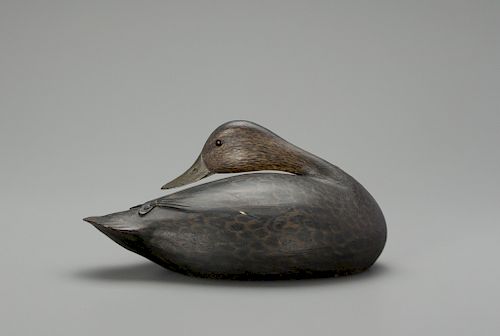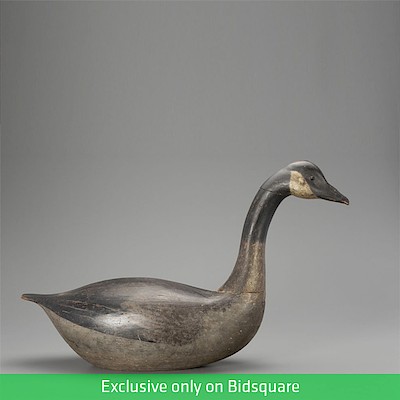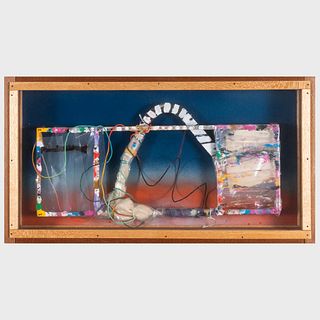Phillips Rig Preening Black Duck, A. Elmer Crowell (1862-1952)
Lot 14
About Seller
Copley Fine Art Auctions
20 Winter Street
Pembroke, MA 02359
United States
Founded in 2005, Copley Fine Art Auctions is a boutique auction house specializing in antique decoys and American, sporting, and wildlife paintings. Over the course of the last two decades, the firm has set auction records for not only individual decoy makers, but also entire carving regions. Copley...Read more
Estimate:
$200,000 - $300,000
Absentee vs Live bid
Two ways to bid:
- Leave a max absentee bid and the platform will bid on your behalf up to your maximum bid during the live auction.
- Bid live during the auction and your bids will be submitted real-time to the auctioneer.
Bid Increments
| Price | Bid Increment |
|---|---|
| $0 | $50 |
| $1,000 | $100 |
| $2,500 | $250 |
| $5,000 | $500 |
| $10,000 | $1,000 |
| $25,000 | $2,500 |
| $50,000 | $5,000 |
About Auction
By Copley Fine Art Auctions
Jul 19, 2018
Set Reminder
2018-07-19 13:00:00
2018-07-19 13:00:00
America/New_York
Bidsquare
Bidsquare : The Sporting Sale 2018, Day 1
https://www.bidsquare.com/auctions/copley/the-sporting-sale-2018-day-1-3286
On July 19, Copley Fine Art Auctions will lead off their annual Sporting Sale with 140 lots from the Donal C. O’Brien, Jr. Collection of Important American Sporting Art and Decoys. On July 20 Copley will present an additional 425 lots of decoys, fish carvings, and sporting art. Copley Fine Art Auctions cinnie@copleyart.com
On July 19, Copley Fine Art Auctions will lead off their annual Sporting Sale with 140 lots from the Donal C. O’Brien, Jr. Collection of Important American Sporting Art and Decoys. On July 20 Copley will present an additional 425 lots of decoys, fish carvings, and sporting art. Copley Fine Art Auctions cinnie@copleyart.com
- Lot Description
Phillips Rig Preening Black Duck
A. Elmer Crowell (1862-1952)
East Harwich, MA, c. 1912
13 in. long
This decoy is a rigmate to the Dr. John C. Phillips (1876-1938) preening pintail that has set the world record for a decoy on three separate occasions. A testament to the standard Crowell set for his major patron, this Phillips rig black duck also holds the distinction of setting the world record for any decoy at auction when it was last offered for sale in 1986. The similarities of form, raised wing carving, and exceptional paint execution between the Phillips rig pintail and this black duck are striking and showcase the maker's fine skills as “the father of American bird carving.”
This early carving conveys Crowell's complete understanding of the species, with the full-bodied duck exhibiting perfect proportions, clean lines, and a head that fully extends back over the left side. The head reveals meticulously blended paint and refined carving details. The wingtips are both crossed and raised, and the tail showcases the carver's very best incising. The body displays the maker's exceptional wet-on-wet dry brush feathering and is perhaps the best paint seen on any Crowell black duck. While the extreme refinement of the carving and paint initially suggests that this bird was made as a decorative, the rigging marks on the bottom attest to its use on the water as a hunting decoy.
Black duck decoys were Crowell’s signature species with hundreds carved in typical straight-head positions. His preening models are indeed rare and reside in the country’s top private and museum collections. "The Magazine Antiques" cemented the iconic status of the Crowell preening black duck when they chose a related example for their September 1989 cover.
Outstanding original paint with minor touch-up.
Provenance: Dr. John C. Phillips Rig
Donal C. O'Brien, Jr. Collection
Literature: William Doyle Galleries, Waterfowl and Shorebird Decoys, New York, New York, April 16, 1986, front cover and lot 81, exact decoy illustrated.
Robert H. Boyle, “The Art of Deception,” Audubon Magazine, May/June 2002, p. 44, exact decoy illustrated.
Stephen B. O'Brien, Jr. and Chelsie W. Olney, "Elmer Crowell: Father of American Bird Carving," Hingham, MA, 2018, exact decoy illustrated.
David S. Webster and William Kehoe, "Decoys at Shelburne Museum," Burlington, VT, 1961, p. 23, no. D-43-W, similar decoy illustrated.
Adele Earnest, "The Art of the Decoy: American Bird Carvings," New York, NY, 1965, p. 172, pl. 148, similar decoy illustrated.
Laurence Sheehan, "The Sporting Life," New York, NY, 1992, pp. 82-83, exact decoy illustrated.Condition report requests can be made via email or by telephone (info@copleyart.com or 617.536.0030). Any condition statement given is a courtesy to customers, Copley will not be held responsible for any errors or omissions. The absence of a condition statement does not imply that the lot is in perfect condition.Condition
- Shipping Info
-
Shipping info
Copley Fine Art Auctions does not handle the shipping of any items. Shipping is the sole responsibility of the buyer. Once your payment has cleared, and we have received your authorized shipping release form items may be released for shipment. Copley Fine Art Auctions, LLC shall have no liability for any loss or damage to such items. Buyers should allow up to four weeks for shipment.PLEASE BE AWARE THAT INTERNET BIDDERS MAY NOT PICK UP THEIR ITEMS AT THE SALE SITE. ITEMS CAN BE PICKED UP BY APPOINTMENT OR SHIPPED STARTING FIVE DAYS AFTER THE CONCLUSION OF THE SALE
-
- Buyer's Premium



 EUR
EUR CAD
CAD AUD
AUD GBP
GBP MXN
MXN HKD
HKD CNY
CNY MYR
MYR SEK
SEK SGD
SGD CHF
CHF THB
THB


















